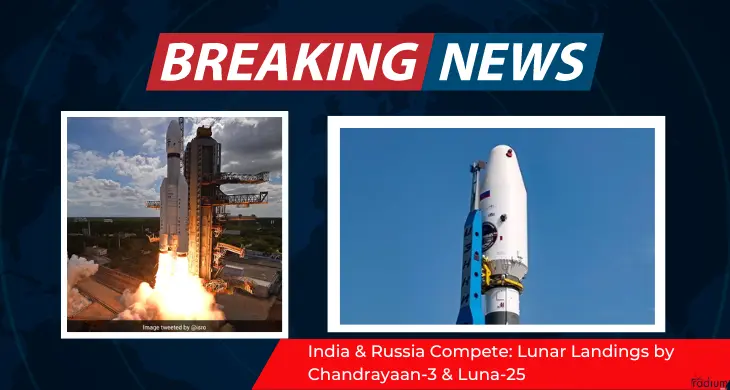The pursuit of unexplored lunar frontiers has entered an electrifying phase as India’s Chandrayaan-3 and Russia’s Luna-25 prepare for their upcoming lunar landings. This captivating competition not only symbolizes scientific advancement but also holds significant implications for space exploration and the global community.
Chandrayaan-3 & Luna-25
In New Delhi, the race to the uncharted Moon’s south pole gains momentum as India’s Chandrayaan-3 and Russia’s Luna-25 prepare for lunar landings next week. Beyond the competition, both missions hold significant implications, with Chandrayaan-3 aiming to be the first at the south pole. Experts highlight Luna-25’s swift trajectory, adding to the anticipation as their landing dates, August 21-23 and August 23-24 respectively, draw global attention due to possible overlap.
Chandrayaan-3, India’s third lunar mission, commenced its journey on July 14, 2023, and successfully entered lunar orbit by August 5. With careful orbital adjustments, it’s gearing up for a soft landing attempt within 40 days of launch.
Marking Russia’s significant return to lunar exploration after nearly five decades since Luna-24 in 1976, Luna-25 launched on August 10. Taking a direct route to the Moon, it holds the possibility of attempting a landing as soon as August 21, within approximately 11 days.
The accelerated trajectory owes itself to the mission’s streamlined construction and optimized fuel storage, facilitating a swifter route to its target.
Will the competition yield meaningful outcomes between Lunar Landings by Chandrayaan-3 & Luna-25?”
Probes whether the ongoing competition between the Chandrayaan-3 and Luna-25 missions will result in significant and valuable results in the context of lunar exploration.
As Chandrayaan-3 and Luna-25 compete to achieve successful lunar landings, their missions carry broader implications beyond the immediate goal of reaching the Moon’s surface. The outcomes of this competition can be meaningful in several ways:
- Scientific Discoveries: Both missions aim to collect valuable data about the Moon’s composition, surface characteristics, and potential resources. The outcomes can enrich our understanding of lunar geology, its history, and the conditions on the Moon.
- Technological Advancements: The competition drives nations to develop cutting-edge technologies required for successful lunar landings. The advancements made during these missions can contribute to the development of more efficient and reliable space exploration technologies.
- Global Collaboration: The competition highlights the global interest in lunar exploration and the collaboration among nations. The outcomes can foster international cooperation, paving the way for joint missions and shared research in the future.
- Inspiration and Education: The achievements and challenges faced by these missions can inspire the next generation of scientists, engineers, and space enthusiasts. The outcomes can stimulate interest in space science and technology, leading to further advancements.
- Space Exploration Roadmap: The outcomes can influence the strategies and priorities of space agencies and governments in their pursuit of future space exploration missions, including crewed lunar missions and beyond.
Frequently Asked Question:
Q1: What is the significance of the competition between India and Russia for lunar landings?
A1: The competition reflects the growing global interest in space exploration and the Moon. It showcases advancements in technology, fosters international collaboration, and contributes to our understanding of celestial bodies.
Q2: What are Chandrayaan-3 and Luna-25 missions?
A2: Chandrayaan-3 is India’s third lunar mission aiming for a soft landing on the Moon’s south pole. Luna-25 is Russia’s lunar mission, marking its return to lunar exploration after decades, with a focus on the Moon’s south pole.
Q3: Why are both missions targeting the Moon’s south pole?
A3: The Moon’s south pole is of immense interest due to its potential water ice deposits and unique geological features that hold insights into the Moon’s history and evolution.
Q4: What are the differences in approach between Chandrayaan-3 and Luna-25?
A4: Chandrayaan-3 is India’s attempt to achieve a successful soft landing on the Moon, emphasizing its expertise in space technology. Luna-25, Russia’s mission, focuses on quick progress and direct trajectory to the lunar surface.
Q5: How might the timing of their landings impact the outcomes of these missions?
A5: The timing may not significantly alter mission outcomes but emphasizes the shared commitment to lunar exploration and paves the way for further research.
Q6: What challenges do these missions face in landing on the Moon’s surface?
A6: The Moon’s challenging terrain, navigation precision, communication during descent, and avoiding obstacles are some of the critical challenges both missions must address.
Q7: How will the success of these missions contribute to our understanding of the Moon and space exploration?
A7: Successful landings will provide valuable data about lunar geology, resources, and environmental conditions. It also paves the way for future missions, including crewed lunar exploration.
Q8: What role does international cooperation play in space exploration?
A8: International collaboration enhances the sharing of expertise, resources, and knowledge, accelerating scientific advancements and promoting peaceful exploration of space.
Conclusion
India & Russia Compete: Lunar Landings by Chandrayaan-3 & Luna-25″ refers to the competitive efforts of India and Russia in their respective lunar exploration missions, Chandrayaan-3 and Luna-25. Both countries are striving to achieve successful landings on the Moon’s surface as part of their space exploration endeavors. This competition not only showcases scientific and technological advancements but also highlights the global significance of space exploration and cooperation. The title encapsulates the exciting race between the two nations to achieve successful lunar landings and the implications of their efforts for the broader field of space exploration.

